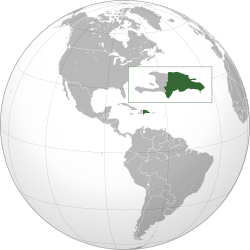
Back Generální kapitanát Santo Domingo Czech Capitanía general de Santo Domingo Spanish Santo Domingoko kapitaintza nagusia Basque Capitainerie générale de Saint-Domingue French Kapitenn Jeneral Sendomeng HT Kekaptenjenderalan Santo Domingo ID Capitaneria generale di Santo Domingo Italian Santo Domingo generalkapitonija Lithuanian Capitania-Geral de São Domingos Portuguese Generalkaptenskapet Santo Domingo Swedish
Captaincy General of Santo Domingo (1521-1821) Province of Santo Domingo (1861-1865) Capitania General de Santo Domingo (Spanish) | |||||||||||
|---|---|---|---|---|---|---|---|---|---|---|---|
| 1521–1865 | |||||||||||
coat of arms of the Captaincy General of Santo Domingo
| |||||||||||
| Motto: Plus Ultra "Further Beyond" | |||||||||||
| Anthem: Marcha Real "Royal March" (1775–1821) | |||||||||||
Left: Flag of Spain (18): first national flag of Spain; Right: Flag of the Province of Santo Domingo)  | |||||||||||
 Map of the Captaincy of Santo Domingo | |||||||||||
| Status | Captaincy General of the Spanish Empire (1521-1821) Province of the Spanish Empire (1861-1865) | ||||||||||
| Capital | Santo Domingo | ||||||||||
| Official languages | Spanish | ||||||||||
| Religion | Roman Catholicism (official) | ||||||||||
| King | |||||||||||
• 1492-1504 | Isabella I of Castile (first) | ||||||||||
• 1861-1865 | Isabella II (last) | ||||||||||
| Governor | |||||||||||
• 1492-1499 | Christopher Columbus (first) | ||||||||||
• 1864-1865 | José de la Gándara y Navarro (Last) | ||||||||||
| Legislature | Council of the Indies Ministry of Overseas (Spain) | ||||||||||
| Historical era | Colonial era | ||||||||||
| 1492 | |||||||||||
• Captaincy created | 13 August 1521 | ||||||||||
• Santo Domingo annexed to France | 1795 | ||||||||||
• Santo Domingo returned to Spain | 1815 | ||||||||||
• Unrecognized independence | 1821 | ||||||||||
• Reincorporated into Spain as a Province of Spain | 1861 | ||||||||||
• Disestablished | 1865 | ||||||||||
| Currency | Spanish colonial real | ||||||||||
| |||||||||||
| History of the Dominican Republic |
|---|
 |
| Pre-Spanish Hispaniola (–1492) |
| Captaincy General of Santo Domingo (1492–1795) |
| French Santo Domingo (1795–1809) |
| España Boba (1809–1821) |
| Republic of Spanish Haiti (1821–1822) |
|
|
| Republic of Haiti (1822–1844) |
|
|
| First Republic (1844–1861) |
|
|
| Spanish occupation (1861–1865) |
| Second Republic (1865–1916) |
| United States occupation (1916–1924) |
| Third Republic (1924–1965) |
| Fourth Republic (1966–) |
| Topics |
|
LGBT history Postal history Jewish history |
|
|
The Captaincy General of Santo Domingo (Spanish: Capitanía General de Santo Domingo pronounced [kapitaˈni.a xeneˈɾal de ˈsanto ðoˈmiŋɡo] ) was the first Capitancy in the New World, established by Spain in 1492 on the island of Hispaniola. The Capitancy, under the jurisdiction of the Real Audiencia of Santo Domingo, was granted administrative powers over the Spanish possessions in the Caribbean and most of its mainland coasts, making Santo Domingo the principal political entity of the early colonial period.[1]
Due to its strategic location, the Captaincy General of Santo Domingo served as headquarters for Spanish conquistadors on their way to the mainland and was important in the establishment of other European colonies in the Western Hemisphere. It is the site of the first European city in the Americas, Santo Domingo, and of the oldest castle, fortress, cathedral, and monastery in the region. The colony was a meeting point of European explorers, soldiers, and settlers who brought with them the culture, architecture, laws, and traditions of the Old World.
The colony remained a military stronghold of the Spanish Empire for over a century, successfully defending against British, Dutch, and French expeditions into the region until the early 17th century. After pirates working for the French colonial empire took over part of the west coast, French settlers arrived and decades of armed conflict ensued. Spain finally ceded the western third of Hispaniola to France in the 1697 Peace of Ryswick, thus establishing the basis for the future nations of the Dominican Republic and Haiti.
- ^ Spain (1680). Recopilación de las Leyes de Indias. Titulo Quince. De las Audiencias y Chancillerias Reales de las Indias. Madrid. Spanish-language facsimile of the original.
© MMXXIII Rich X Search. We shall prevail. All rights reserved. Rich X Search
